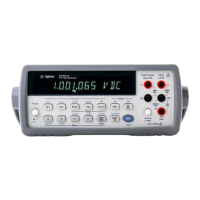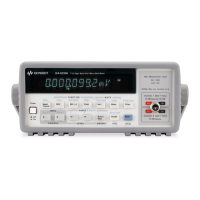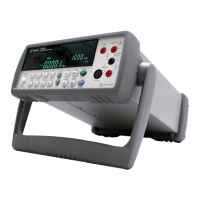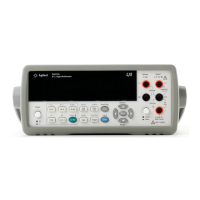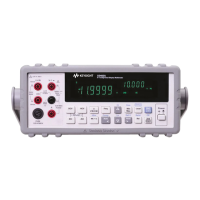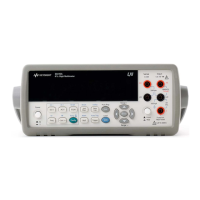88 Chapter 4 Making Measurements
The following example uses EXT as the sample event. The trigger event is
synchronous (selected by the PRESET NORM command). The number of
readings per trigger event is set to 10. When the controller executes line 50,
the synchronous event occurs which enables the sample event (EXT). Upon
the arrival of a negative edge transition on the Ext Trig terminal, the
multimeter takes a single reading, which is transferred, to the controller. A
second negative edge transition initiates the second reading, which is
transferred to the controller. This sequence continues until all 10 readings
are completed and transferred to the controller.
10 OPTION BASE 1 !COMPUTER ARRAY NUMBERING STARTS AT 1
20 DIM Rdgs(l0) !DIMENSION ARRAY FOR READINGS
30 OUTPUT 722;"PRESET NORM" !TARM AUTO, TRIG SYN, DCV AUTORANGE
40 OUTPUT 722;"NRDGS 10,EXT" !10 READINGS/TRIGGER, EXTERNAL SAMPLE EVENT
50 ENTER 722;Rdgs(*) !ENTER READINGS
60 PRINT Rdgs(*) !PRINT READINGS
70 END
Note Refer to the “EXTOUT Signal” later in this chapter, for examples showing
how to synchronize the multimeter to an external scanning device.
External Trigger
Buffering
Trigger buffering corrects for an error (TRIGGER TOO FAST) that can
occur when using the external (EXT) trigger arm, trigger, or sample event.
With trigger buffering disabled, any external trigger signal that occurs during
a rending generates the TRIGGER TOO FAST error and the trigger(s) are
ignored. With trigger buffering enabled, the first external trigger that occurs
during a reading is stored and no error is generated by this or any successive
triggers. After the reading is complete, the stored trigger satisfies the EXT
event if the multimeter is so programmed. Trigger buffering is useful when
you are using an external scanning device synchronized to the multimeter's
EXTOUT signal using the input complete (ICOMP) event. Since the ICOMP
pulse occurs before each reading is finished, it is possible for the scanner to
close the next channel and generate its channel closed pulse (which is used
to trigger the multimeter) before the reading is complete. (Refer to "Input
Complete", later in this chapter, for more information.) In the multimeter's
power-on state, trigger buffering is disabled. To enable trigger buffering,
send:
OUTPUT 722;"TBUFF ON"
To disable trigger buffering, send:
OUTPUT 722; "TBUFF OFF"
Event Combinations You can specify many combinations of the trigger arm, trigger, and sample
events to suit your application. Table 21 shows, all possible combinations of
these events and describes the resultant triggering sequence for each.

